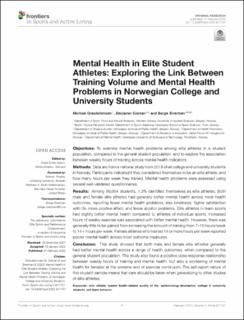| dc.contributor.author | Grasdalsmoen, Michael | |
| dc.contributor.author | Clarsen, Benjamin Matthew | |
| dc.contributor.author | Sivertsen, Børge | |
| dc.date.accessioned | 2022-04-21T11:47:50Z | |
| dc.date.available | 2022-04-21T11:47:50Z | |
| dc.date.created | 2022-02-01T10:03:17Z | |
| dc.date.issued | 2022 | |
| dc.identifier.citation | Frontiers in Sports and Active Living. 2022, 4, Artikkel 817757. | en_US |
| dc.identifier.issn | 2624-9367 | |
| dc.identifier.uri | https://hdl.handle.net/11250/2991986 | |
| dc.description | This is an open-access article distributed under the terms of the Creative Commons Attribution License (CC BY). The use, distribution or reproduction in other forums is permitted, provided the original author(s) and the copyright owner(s) are credited and that the original publication in this journal is cited, in accordance with accepted academic practice. No use, distribution or reproduction is permitted which does not comply with these terms. | en_US |
| dc.description.abstract | Objectives: To examine mental health problems among elite athletes in a student population, compared to the general student population, and to explore the association between weekly hours of training across mental health indicators.
Methods: Data are from a national study from 2018 of all college and university students in Norway. Participants indicated if they considered themselves to be an elite athlete, and how many hours per week they trained. Mental health problems were assessed using several well-validated questionnaires.
Results: Among 50,054 students, 1.3% identified themselves as elite athletes. Both male and female elite athletes had generally better mental health across most health outcomes, reporting fewer mental health problems, less loneliness, higher satisfaction with life, more positive affect, and fewer alcohol problems. Elite athletes in team sports had slightly better mental health compared to athletes of individual sports. Increased hours of weekly exercise was associated with better mental health. However, there was generally little to be gained from increasing the amount of training from 7–10 hours/week to 14+ hours per week. Female athletes who trained 14 or more hours per week reported poorer mental health across most outcome measures.
Conclusion: This study showed that both male and female elite athletes generally had better mental health across a range of health outcomes, when compared to the general student population. The study also found a positive dose-response relationship between weekly hours of training and mental health, but also a worsening of mental health for females at the extreme end of exercise continuum. The self-report nature of this student sample means that care should be taken when generalizing to other studies of elite athletes. | en_US |
| dc.language.iso | eng | en_US |
| dc.subject | college & university students | en_US |
| dc.subject | elite athlete | en_US |
| dc.subject | epidemiology-descriptive | en_US |
| dc.subject | mental health-related quality of life | en_US |
| dc.subject | self-harm behavior | en_US |
| dc.title | Mental health in elite student athletes: Exploring the link between training volume and mental health problems in Norwegian college and university students | en_US |
| dc.type | Peer reviewed | en_US |
| dc.type | Journal article | en_US |
| dc.description.version | publishedVersion | en_US |
| dc.rights.holder | © 2022 Grasdalsmoen, Clarsen and Sivertsen | en_US |
| dc.source.pagenumber | 12 | en_US |
| dc.source.volume | 4 | en_US |
| dc.source.journal | Frontiers in Sports and Active Living | en_US |
| dc.identifier.doi | 10.3389/fspor.2022.817757 | |
| dc.identifier.cristin | 1996074 | |
| dc.description.localcode | Institutt for idrettsmedisinske fag / Department of Sports Medicine | en_US |
| dc.source.articlenumber | 817757 | en_US |
| cristin.ispublished | true | |
| cristin.fulltext | original | |
| cristin.qualitycode | 1 | |
